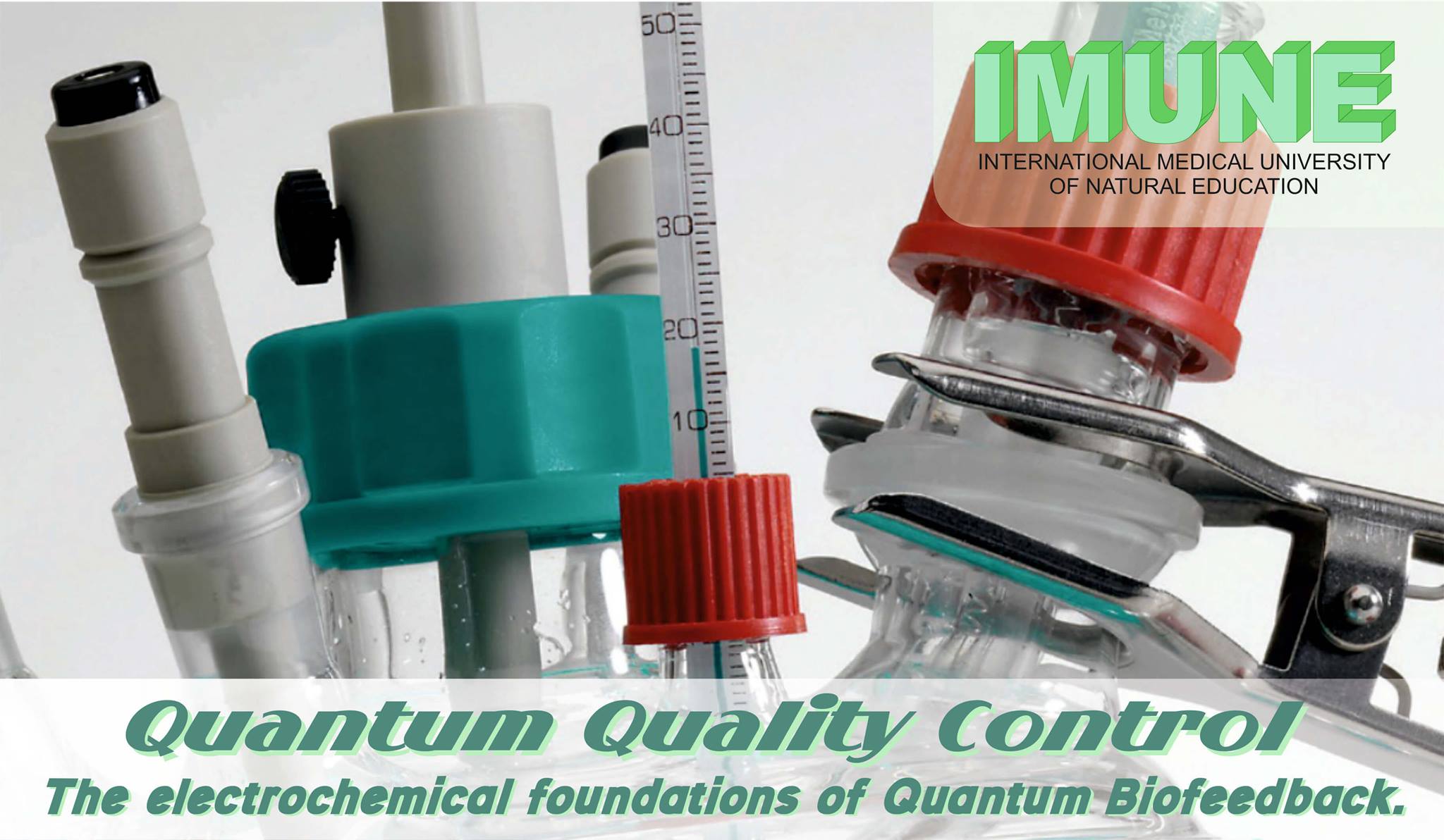Quantum Quality Control (QQC) an additional quality control
The electrochemical foundations of Quantum Biofeedback
Quantum Quality Control (QQC) is an advanced method used to ensure the purity, potency, and quality of substances, particularly in the field of essential oils, supplements, and other natural products. QQC employs electrochemical measurements—such as voltage and amperage—along with capacitance measurements to capture the precise electrical properties of a substance. The data gathered is then analyzed using Fourier Transform to convert signals into the time domain, providing a clear, quantifiable analysis of the material’s quality and consistency.
Here are the scientific principles and technologies behind Quantum Quality Control:
1. Electrochemical Measurements: Voltage and Amperage
Electrochemical techniques, which involve measuring voltage (potential difference) and amperage (current), are widely used in analytical chemistry to evaluate the quality of substances. By applying these techniques to essential oils or other substances, QQC can detect impurities or variations in chemical composition, ensuring consistency and efficacy.
- A study in the Journal of Electroanalytical Chemistry highlights how electrochemical methods are used to analyze natural compounds, including essential oils. Voltage and current measurements help identify specific electrochemical signatures, allowing for detailed characterization of the sample’s composition and quality .
- Another research article in Electrochimica Acta discusses the application of electrochemical techniques for the quality control of natural products. Voltage and amperage measurements help identify potential contaminants, and changes in electrical properties can indicate degradation or variation in substance quality .
2. Capacitance Measurements
Capacitance refers to the ability of a substance to store electrical charge, and it can reveal important information about a material’s molecular structure and purity. In Quantum Quality Control, capacitance measurements are taken to further characterize the electrochemical behavior of the substance.
- A paper published in Sensors and Actuators B: Chemical outlines the use of capacitance measurements in determining the purity and consistency of biological and chemical samples. The capacitance response of a material is sensitive to changes in its chemical composition, making it a valuable parameter in quality control .
- Another study in Analytical Chemistry supports the use of capacitance as a reliable tool for material characterization, particularly in identifying subtle variations in substance quality and confirming the uniformity of essential oil products .
3. Fourier Transform Analysis in Time Domain
Fourier Transform is a mathematical technique used to convert complex signals into simpler components, typically switching from the frequency domain to the time domain. By analyzing the time-domain signal of a substance, QQC provides a highly detailed and accurate profile of the material’s electrochemical behavior.
- The application of Fourier Transform for electrochemical data is widely accepted. A study in Electrochimica Acta shows how Fourier transform can be used to analyze time-domain signals generated by electrochemical data (voltage, current, capacitance), offering insights into the material’s quality and detecting any inconsistencies .
- Another research article in Journal of Chemical Education demonstrates the use of Fourier transform for signal processing in electrochemical analysis, where time-domain data provides a clearer picture of the underlying electrochemical reactions in the substance, helping identify quality and purity .
4. Combining Electrochemical Techniques and Fourier transform for Quality Control
Quantum Quality Control (QQC) integrates these methods—electrochemical measurements, capacitance analysis, and Fourier transform —into a unified approach that ensures the utmost quality in essential oils and other natural products. The combination of these advanced techniques allows for a thorough examination of the molecular structure, purity, and potency of each batch.
- An article in Analytica Chimica Acta discusses the combined use of electrochemical analysis and Fourier Transform to measure the quality of natural products. By analyzing the electrical properties and converting them into time-domain data, manufacturers can ensure that products meet stringent quality standards .
- A study from Talanta also highlights the use of Fourier transform and electrochemical measurements to monitor the quality of pharmaceutical and botanical products. This multi-faceted approach provides a high-resolution analysis of product consistency and purity, ensuring that each batch adheres to exact quality standards .
Quantum Quality Control (QQC) is an advanced method that applies scientifically-backed electrochemical techniques to ensure the highest quality of essential oils and natural products. Through voltage, amperage, and capacitance measurements, combined with Fourier Transform analysis, QQC provides a clear and accurate picture of a product’s molecular composition. The application of these technologies ensures that each product is pure, potent, and effective, backed by rigorous scientific research and modern electrochemical analysis.

Step-by-Step Combining Electrochemical Techniques and Fourier transform for Quality Control
The Quantum Quality Control (QQC) method integrates advanced electrochemical measurements and Fourier Transform analysis to ensure the quality of substances like essential oils or natural products. Below is a detailed step-by-step explanation of how this process works:
Step 1: Sample Preparation
The first step in the QQC process is preparing the sample for electrochemical measurement. Depending on the type of substance (e.g., essential oil, extract), a small amount of the sample is placed into an appropriate container or electrochemical cell.
- Materials Required: Electrochemical cell, electrodes, sample holder
- Goal: Prepare a pure, uncontaminated sample for accurate electrochemical testing.
Step 2: Electrochemical Measurement Setup
Once the sample is prepared, it is subjected to electrochemical testing. The most commonly measured electrochemical parameters are voltage (potential difference) and amperage (current). These parameters reveal key properties of the sample’s molecular composition, such as its oxidation-reduction potential (redox behavior) and how it interacts with electricity.
- Electrochemical Equipment: Potentiostat/galvanostat, working electrode, counter electrode, and reference electrode
- Measurement Methods:
- Voltammetry: Measures the current as a function of applied voltage to determine redox properties.
- Amperometry: Measures the current passing through the sample at a fixed voltage, indicating reaction rates.
- Goal: Gather raw electrochemical data that reflects the sample’s quality and behavior.
Step 3: Capacitance Measurement
In addition to voltage and current, capacitance is measured to evaluate the material’s ability to store electrical charge. Capacitance measurements are sensitive to molecular changes and provide further insights into the sample’s structure, purity, and consistency.
- Capacitance Equipment: Capacitance meter, dielectric measurement setup
- Goal: Record the capacitance to assess the electrochemical storage properties of the sample.
Step 4: Data Collection and Recording
All electrochemical and capacitance data is recorded digitally. These measurements create a complex dataset consisting of signals over time (time-domain data) and frequencies (frequency-domain data). These signals reflect the sample’s overall electrochemical behavior, but to extract meaningful insights, more advanced analysis is required.
- Tools Used: Data acquisition software, sensors, and electrodes
- Goal: Collect voltage, current, and capacitance data, creating a signal dataset.
Step 5: Fourier Transform Analysis
Once the data is gathered, Fast Fourier Transform is applied to analyze the signal in the time domain. This mathematical process converts the collected electrochemical signals from the frequency domain into the time domain, allowing for the identification of specific patterns or irregularities in the material’s electrochemical properties.
- Specialized software like is used to run the analysis.
- Process:
- The electrochemical signals (voltage, current, and capacitance) are processed to generate a time-domain graph.
- The software breaks the complex data into simpler sine waves, making it easier to identify key characteristics like signal amplitude, phase shifts, and frequency components.
- Goal: To analyze the electrochemical signature and identify variations, impurities, or potential degradation of the sample.
Step 6: Interpretation of Fourier Transform Results
Once the data is processed using Fourier Transform, the resulting time-domain data is interpreted by comparing it against known benchmarks for high-quality products. Specific patterns, like signal spikes or deviations, can indicate impurities, changes in composition, or other quality issues.
- Tools for Interpretation: Quality control benchmarks, Fourier transform analysis software
- Goal: Detect any inconsistencies or deviations from expected quality standards by examining the processed signal.
Step 7: Quality Verification
The final step is verifying the product’s quality based on the interpreted data. If the substance’s electrochemical profile matches the desired standard, it is approved for production. If deviations or impurities are detected, the product may need further refinement or rejection.
- Final Decision: The sample is either approved or flagged for inconsistencies.
- Goal: Ensure that the product meets strict quality standards before it reaches consumers.
Summary of Key Steps in Quantum Quality Control:
- Sample Preparation: Preparing the material in an electrochemical cell.
- Electrochemical Measurements: Recording voltage and current using voltammetry or amperometry.
- Capacitance Measurement: Measuring the charge storage capacity of the sample.
- Data Collection: Gathering all electrochemical data digitally for analysis.
- Fourier transform Analysis: Applying Fourier Transform to convert time-domain signals into frequency-domain signals.
- Result Interpretation: Comparing time-domain data to identify any quality issues.
- Quality Verification: Making a final judgment based on the processed electrochemical data.
Through these steps, Quantum Quality Control ensures the highest standard of purity, potency, and consistency in essential oils or other natural substances. The combination of electrochemical measurements and Fourier transform allows for a deep, precise analysis of the substance’s quality, making it a reliable method for modern quality control.

